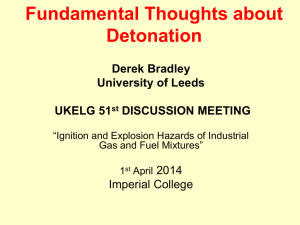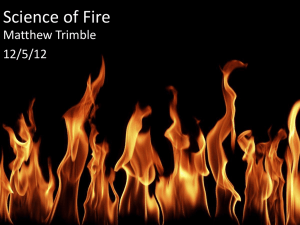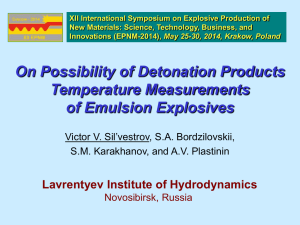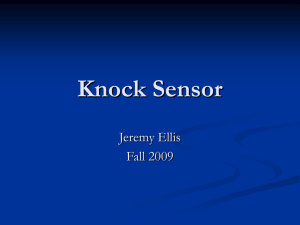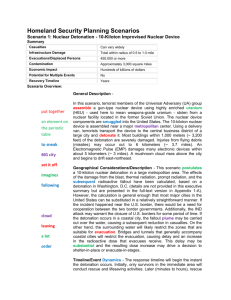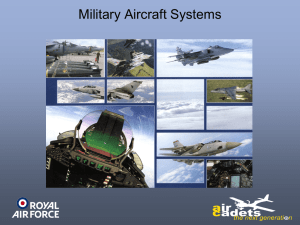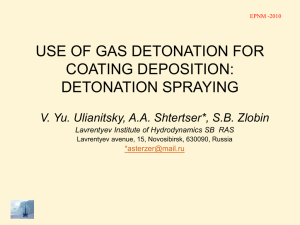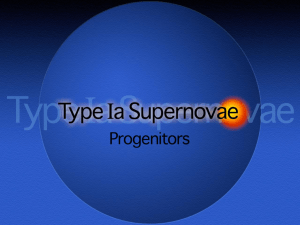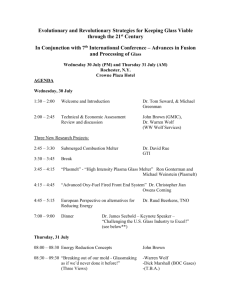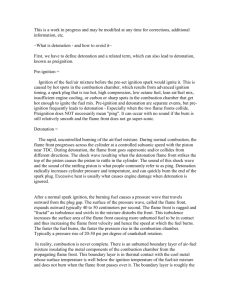1. Introduction
advertisement
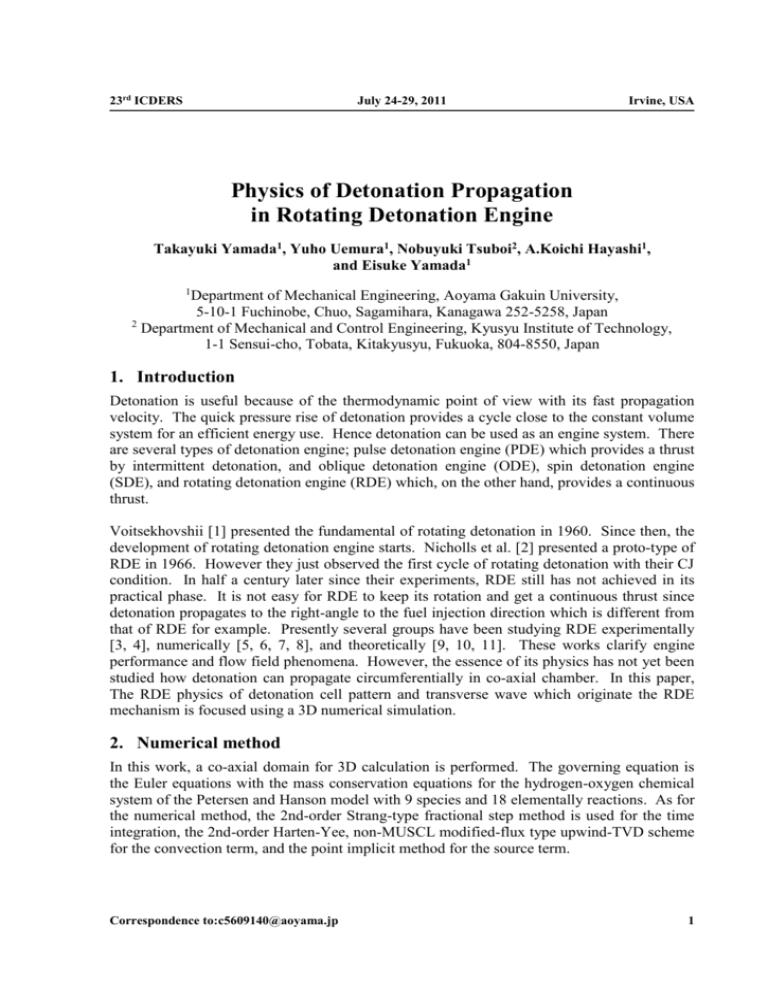
23rd ICDERS July 24-29, 2011 Irvine, USA Physics of Detonation Propagation in Rotating Detonation Engine Takayuki Yamada1, Yuho Uemura1, Nobuyuki Tsuboi2, A.Koichi Hayashi1, and Eisuke Yamada1 1 Department of Mechanical Engineering, Aoyama Gakuin University, 5-10-1 Fuchinobe, Chuo, Sagamihara, Kanagawa 252-5258, Japan 2 Department of Mechanical and Control Engineering, Kyusyu Institute of Technology, 1-1 Sensui-cho, Tobata, Kitakyusyu, Fukuoka, 804-8550, Japan 1. Introduction Detonation is useful because of the thermodynamic point of view with its fast propagation velocity. The quick pressure rise of detonation provides a cycle close to the constant volume system for an efficient energy use. Hence detonation can be used as an engine system. There are several types of detonation engine; pulse detonation engine (PDE) which provides a thrust by intermittent detonation, and oblique detonation engine (ODE), spin detonation engine (SDE), and rotating detonation engine (RDE) which, on the other hand, provides a continuous thrust. Voitsekhovshii [1] presented the fundamental of rotating detonation in 1960. Since then, the development of rotating detonation engine starts. Nicholls et al. [2] presented a proto-type of RDE in 1966. However they just observed the first cycle of rotating detonation with their CJ condition. In half a century later since their experiments, RDE still has not achieved in its practical phase. It is not easy for RDE to keep its rotation and get a continuous thrust since detonation propagates to the right-angle to the fuel injection direction which is different from that of RDE for example. Presently several groups have been studying RDE experimentally [3, 4], numerically [5, 6, 7, 8], and theoretically [9, 10, 11]. These works clarify engine performance and flow field phenomena. However, the essence of its physics has not yet been studied how detonation can propagate circumferentially in co-axial chamber. In this paper, The RDE physics of detonation cell pattern and transverse wave which originate the RDE mechanism is focused using a 3D numerical simulation. 2. Numerical method In this work, a co-axial domain for 3D calculation is performed. The governing equation is the Euler equations with the mass conservation equations for the hydrogen-oxygen chemical system of the Petersen and Hanson model with 9 species and 18 elementally reactions. As for the numerical method, the 2nd-order Strang-type fractional step method is used for the time integration, the 2nd-order Harten-Yee, non-MUSCL modified-flux type upwind-TVD scheme for the convection term, and the point implicit method for the source term. Correspondence to:c5609140@aoyama.jp 1 Takayuki Yamada et.al Physics of Detonation Propagation in Rotating Detonation Engine The initial condition is as follows; the ambient pressure is 0.1 MPa, and ambient temperature is 300 K. The reservoir pressure has two patterns depending on whether the pressure can maintain the rotation or not. There are two boundary condition systems for gas injection; one is the supersonic inlet condition and another is the subsonic inlet condition. The supersonic inlet condition is used for the most of experiments since the inlet nozzles for fuel usually have a choked condition at the exit of small nozzles. However the most of real cases may have a subsonic inlet condition. The subsonic inlet condition is discussed by Zhdan et al. [5]. The present calculation is performed on the following four cases. (1) The pressure is extrapolated and velocity is zero when the inlet pressure is higher than the manifold pressure. (2) The pressure is extrapolated when the pressure just before the inlet is lower than the manifold pressure and is higher than the pressure just after the inlet. (3) The pressure s is extrapolated when the inlet pressure is higher than the supersonic condition and lower than the subsonic condition. (4) Pressure becomes supersonic one when the inlet pressure is higher than the supersonic condition. The outlet boundary conditions are given at the exit by two patterns as not to flow backward from downstream to upstream. (1) The exit pressure is extrapolated from the ambient pressure at the cases that the exhaust speed is subsonic. (2) The exit pressure is the outlet pressure at the cases that the exhaust speed is supersonic. The computational domain shows in Fig. 1. For ignition, 1D numerical result of detonation is attached on the light blue section; H2/O2 mixture is filled on the red section and air is filled on the blue section. When calculating the detonation propagating in the circumferential direction, the accuracy of the radial grid which is not enough in the present calculation, but may be enough to know the feature is important in the cylindrical system. Therefore, the finer grids are near outer and inner walls as shown in Fig. 2. The number of grids and its size are shown in Table 1. Fig. 1 Computational domain 23rd ICDERS – July 24-29, 2011 – Irvine Fig. 2 Grid system 2 Takayuki Yamada et.al Grid number Grid size Physics of Detonation Propagation in Rotating Detonation Engine Table 1 Grid condition 601x31x601 Axial direction : 5.0 m Radial direction : 1.5~10 m Circumference direction : approx. 5.0 m 3. Results and discussion Through this 3D calculation, many of the features of rotating detonation obtained in 2D calculations are confirmed such as the cell structure by transverse waves, Kelvin-Helmholtz instabilities, and the propagation mechanism of transverse waves where the triple points are coming from the hot spot at the right hand side of detonation front. We suppose from the present results that the transverse wave yields at the edge of the intersection between the detonation front and the contact surface of the unburnt mixture of hydrogen and oxygen with the burnt gas which goes round one cycle and propagates to the inlet wall (the left hand side of the detonation front). The present 3D calculation made clear the generation of transverse waves. Many of published 2D calculations do not show the detail structure of transverse wave propagation at the detonation front. 3.1 Detonation front structure in rotating detonation engine Since detonation propagates in the circumferential direction, its phenomena have 3D features. Figure 3 shows the pressure iso-surface (200 atm) at the detonation front (vertically and 2dimensionally) and the OH mass fraction distribution on the inner tube wall. At the detonation front, we can see detonation cell patterns where the transverse waves move in the perpendicular direction towards the inlet wall at the whole detonation front. This transverse wave hits at the inlet wall and micro explosions occur there, then reflects towards the outlet up to the hot spot. In the downstream side, there is no wall but the transverse wave yields at this hot spot. At the time we calculated this phenomena two-dimensionally, we thought the transverse wave reflects at this hot spot, but from 3D results we understood that the transverse wave emerges from the point where the detonation front interacts with the contact surface between the hydrogen flow from the inlet wall and the detonation tail burnt products from the previous cycle. 3.2 Hot spot configuration in 3D rotating detonation structure Figure 4 shows the OH mass fractional isosurface (YOH: 0.1[green] and 0.18[orange]). The hot reaction zone is distributed at the detonation front. Many triple point trails are seen from the detonation front to downward parallel to the inlet wall. Especially the centrifugal force may give the situation that the high pressure region and hot spot region move to the outer wall, which is also seen in Fig.6. 3.3 Kelvin-Helmholtz instability downstream the oblique shock wave Figure 5 shows OH mass fractional isosurface (YOH: 0.1). To the axial direction, the detonation wave disappears, instead, vortices appear behind the oblique shock wave. The speed and density difference between the unburnt and burnt region generates a KelvinHelmholtz (K-H) instability. The K-H instability induces a three-dimensional vortex which 23rd ICDERS – July 24-29, 2011 – Irvine 3 Takayuki Yamada et.al Physics of Detonation Propagation in Rotating Detonation Engine occurs behind the oblique shock wave. Additionally unburnt H2 involves with this vortex. Then, the hot reaction zone generates the transverse wave because at this intersection ignition occurs due to their interaction. These phenomena were also seen in our previous study of 2D numerical simulation [12] although we did not discuss this way. 3.4 Detonation front configurations while it rotates one round Figure 6 shows the detonation front rotates one turn. While it rotates a turn, its pressure configuration changes probably due to a centrifugal force as well as its instability. The pressure becomes higher near the outer wall (red in color or dark) and lower near the inner wall (green or blue in color or light). Fig. 3 Detonation front structure with cell patterns during its rotation together with OH profiles near the inner wall. 23rd ICDERS – July 24-29, 2011 – Irvine 4 Takayuki Yamada et.al Physics of Detonation Propagation in Rotating Detonation Engine Fig.4 3D-OH mass fractional isosurface Fig. 5 K-H instability behind the oblique shock wave Fig.6 Detonation front configuration during a turn in the co-axial tube. 4. Conclusions The 3D numerical analysis is performed for H2/O2 RDE. We could study the characteristic flow field of the detonation propagation from 3D numerical results. Detonation cell pattern is stable behind the detonation wave. The transverse wave reflects at the injection wall (the inlet wall), but not in the opposite side of the wall. Instead the transverse wave generates at this region due to the interaction between the detonation front and the contact surface coming towards the detoantion front. The hot reaction zone appears at this point. The speed and density difference between the unburnt and burnt region generates a Kelvin-Helmholtz instability vortices. This is the physics of the rotating detonation engine we found in the present study. 23rd ICDERS – July 24-29, 2011 – Irvine 5 Takayuki Yamada et.al Physics of Detonation Propagation in Rotating Detonation Engine Acknowledgments This work is supported by KAKENHI (21360420). Numerical calculation is performed using JAXA Supercomputer System in Japan Aerospace Exploration Agency and Large-Scale Computing System in Osaka University. Authors appreciate those supports. References [1] Voitsekhovskii, B.V., (1959), Stationary Detonation, Doklady Akademii Nauk UzSSR, vol. 129, No. 6, pp. 1254-1256 [2] Nicholls, J.A., Cullen, R.E., and Ragland, K.W., (1966), Feasibility Studies of a Rotating Detonation Wave Rocket Motor, Journal of Spacecraft and Rockets, Vol. 3, No. 6, pp. 893-898 [3] Kindaracki, J., Wolanski, P., and Gut, Z., (2009), Experimental Research on the Rotating Detonation in Gaseous Fuels-Oxygen Mixture, 22nd-ICDERS, CD [4] Braun, E.M., Dunn, N.L., and Lu, F.K., (2010), Testing of a Continuous Detonation Wave Engine with Swirled Injection, 48th AIAA Aerospace Sciences Meeting including The New Horizons Forum and Aerospace Exposition, AIAA 2010-146 [5] Zhdan, S.A., Mardashev, A.M., and Mitrofanov, V.V., (1990), Calculation of the Flow of Spin Detonation in an Annular Chamber, Combustion, Explosion, and Shock Waves, Vol. 26, No. 2, pp. 210-21 [6] Yi, T.H., Turangan, C., and Lou, J., (2009), A Three-Dimensional Numerical Study of Rotational Detonation in an Annular Chamber, 47th AIAA Aerospace Sciences Meeting including The New Horizons Forum and Aerospace Exposition, AIAA 2009-634 [7] Schwer,D., Kailasanath, K.,(2011),Numerical Investigation of the Physics of RotatingDetonation-Engines,Proceedings of the Combusion Institute,Volume 33,Issue 2,pp.2195-2202 [8] Hishida,M.,Fujiwara,T.,and Wolanski,P.,(2009),Fundamentals of Rotating Detonations,Shock Waves,Volume 19,No.1,pp.1-10 [9] Braun, E.M., Lu, F.K., Wilson, D.R., and Cambreos, J.A., (2010), Airbreathing Rotating Detonation Wave Engine Cycle Analysis, 46th AIAA/ASME/SAE/ASEE Joint Propulsion Conference & Exhibit, AIAA 2010-7039 [10] Kailasanath, K., (2011), The Rotating-Detonation-Wave Engine Concept: A Brief Status report, 49th AIAA Aerospace Sciences Meeting including The New Horizons Forum and Aerospace Exposition, AIAA 2011-580 [11] Nordeen, C.A., Schwer, D., Schauer, F., Hoke, J.,Cetegen, B., and Barber, T., (2011), Thermodynamic Modeling of a Rotating Detonation Engine, 49th AIAA Aerospace Sciences Meeting including The New Horizons Forum and Aerospace Exposition, AIAA 2011-803 [12] Yamada, T., Hayashi, A.K., Yamada, E, Tsuboi, N., Tangilara., V.E., and Fujiwara, T., (2010), Detonation Limit Thresholds in H2/O2 Rotating Detonation Engine, Combusion Science and Technology, Volume 182, Issue 11 & 12 November, p.1901-1914 23rd ICDERS – July 24-29, 2011 – Irvine 6
